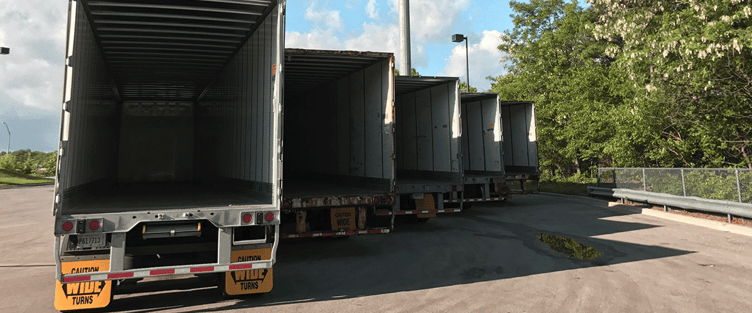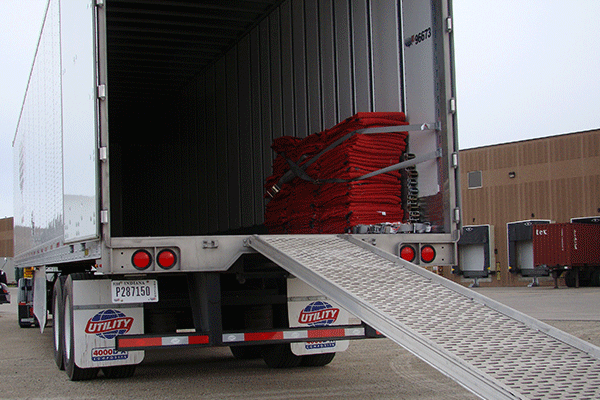
You’re worried about finding capacity this season. Two years ago, no one could’ve predicted the hectic nature of our world over the last 12 months. People, supply chains and businesses have suffered at the hands of a relentless virus and, as the world clambers toward normalcy once more, your shipments are ready to go out the door.
This year, more than any other, it’s important you feel confident that when it’s time for the rubber to meet the open road, your delivery will be serviced on time.
Here at ATS Logistics, we’ve been working alongside the ebbs & flows in capacity demands in the food and beverage industry for decades. Because of our unique experience, we pay close attention to the transportation market — especially this time of year — to make sure the people who rely on us get top-of-the-line service.
Whether or not you choose to ship with ATS Logistics, you deserve to understand why shipping capacity is tight in the food and beverage industry so that when the time comes to move your freight, you’re as prepared as possible
Why is Capacity Tight This Spring?
This spring, you may find that locating adequate capacity for your food and beverage inventories is more difficult than in years of old. But why? Your product is the same as before, your lead time hasn't changed and the partnerships you’ve developed should pay off for you. . . right?
While all of this may be true, this year — like last year — will be a complete test on the infrastructure of our industry. As such, four main factors will influence the price you pay as a business in the food and beverage industry this year.
These factors are:
- The national trailer shortage
- Increased demand for capacity
- Truckers in short supply
- Seasonal shipping capacity restrictions
When working in tandem, these factors can significantly impact your bottom line. As such, you must stay on top of things this year and be more diligent in planning.
The National Trailer Shortage

A year ago, when coronavirus invaded the coasts of our nation and everything shut down, so too did trailer production facilities. Earlier this year, the load to truck ratio for reefers in Phoenix, Ariz. was sitting at a whopping 11.5 to one. This means that for every load of reefer freight that needed to be moved, there were 0.086 trailers available to do so.
This massive deficit — in an industry whose pricing structure is dictated by supply and demand — took a toll. Shippers were scrambling to find a shipping solution and to do so, spent a lot more money to get a truck than they previously would have.
Fast forward to today and you’ll see that although this supply deficiency in the number of trailers available has decreased significantly, it's still an issue.
Because of this, it may cost more to move your freight this year. Your rates may rise and your bottom line could suffer. Although this won’t be the case for every situation, it’s safe to say that the trailer shortage may be — at least partially — at fault when the quoted rate for your lane inevitably increases.
Increased Demand For Capacity
Unfortunately, as the supply of trailers (and truck drivers) has seen a steady decline in the last few years, the demand for their services has sharply risen. In turn, this has led to what can only be described as a capacity crisis in this industry. Demand is on the rise, folks, and — due to these factors — capacity is not rising to meet it.
As such, when you’re planning your shipment this year you may need to pay more than you have previously. Your usual rate may increase simply due to the sheer volume of demand in today’s marketplace. The pricing structure of this industry is dictated by supply and demand.
As the demand for trucks increases this spring, it’s going to be challenging, and more expensive, for shippers across the nation to find dry van and reefer capacity.
Truckers Are In Short Supply
In today’s marketplace, truck drivers are in short supply. Be it: an unwillingness to serve the market because of Coronavirus concerns, the fact that driver schools have been educating at decreased capacity, or the retirement of longtime drivers, there aren't enough truckers around and we desperately need them.
Although your balance sheet has likely already felt the effects of the trucker shortage, keep this in mind this spring. The Food and Beverage industry is no different than any other, especially when it comes to shipping rates. If capacity is needed and there aren’t enough drivers around to serve it, prices rise.
Seasonal Shipping Capacity Restrictions
As you may already suspect, since conditions change so significantly as the seasons change, so too do the rules of the road and seasonal capacity requirements. This year, especially since capacity is already so tight, these seasonal events will play an even larger role in the food and beverage industry.
The capacity restrictions that you should keep in mind this spring are easily tied to produce season and its capacity requirements.

Produce Season
This time of year — beginning in February and ending in late June — tests the trucking industry’s ability to keep up with capacity demands. Spring is the season of rebirth. Flowers bud, grass grows, ice melts and children frolic in the rain.
In this industry, spring is also known for the large volume of produce coming into season. Throughout this time of year, the vegetables and fruit occupying fields across the country are harvested, packaged and distributed. In total, this produce is moved to grocery stores, food manufacturers and various vendors spanning the nation.
Due to the time sensitivity of these perishable items, dry van and reefer capacities in key areas are limited significantly. As such, the current stress on America's supply chain caused by the trailer shortage, driver shortage and rising demand are only magnified in the spring.
Note, the abundance of produce per year is completely dependent on what Mother Nature allows. As such, the amount of impact this makes on the price of your shipping lanes is based on your location and the abundance of produce leaving the fields.
The Waves of Produce Season
This year, finding a transportation partner who can sit down with you and explain how the shifts in produce harvest across the U.S. will impact capacity and price.
Below, I’ve broken the waves of produce coming into season down into three areas so that you have a better grasp on how each of these will impact capacity in your region at each time.
Although this is by no means a comprehensive list, it’ll serve to give you better insight into how the business of “feeding America” impacts capacity in the spring.
Spring Harvest: Southeastern United States
If you’re hoping to find bulk dry van and/or reefer capacity going out of Florida, Georgia, South Carolina or any state in the southeast this spring, you’ll want to pay attention to their fruit harvests. Between the months of February-June fruit like mandarin oranges, mangoes, peaches and grapefruit are center-stage in this region.
Because of the urgency of these shipments — due to their limited shelf life — the price shippers of these products are willing to pay for capacity increases. As such, if you have shipments utilizing lanes in this region, be diligent in your planning.
Spring Harvest: Texas
During the spring harvest, Texas is an absolute hotbed soaking up massive amounts of local and regional shipping capacity. As the first wave of spring corn is ripe for the picking and onions come into season, finding a truck for your food and beverage shipping lanes in Texas will come at a higher price.
Since a large portion of farmers seed their cornfields — a crop that takes an average of 120 days to mature — beginning in early January, harvest rolls around roughly 3 months later in early May. As such, if you’re operating in this region at this time, make sure that you're watching the market diligently and planning ahead for your shipments.
Find a partner who has experience shipping these lanes through Texas in the spring. If practice makes perfect, a practiced provider is your best bet for success.
Spring Harvest: Southwestern United States
The early-late spring harvest throughout Arizona, Nevada and California, presents massive amounts of capacity requirements as produce across the board comes into season. Products such as: asparagus, beets, carrots, celery and cucumbers are torn from the fields and shipped to distribution centers across the country. As these farmers and organizations work to get their produce into the hands of people across America, capacity will tighten for all nearby shippers.
Although the Southeast, Texas and Southwest aren’t the only areas of the U.S. that feel the impact of harvest seasons, they are the main areas you’ll want to pay attention to as you move your freight during the months of April through June.
As we transition into summer and the weather changes, so too will the regions that are “hot” for capacity.
June through October is peak Apple season in the Northeast. In July to December, wheat and soybeans steal the show in the Midwest.
In the end, it all comes back to timing. Pick a transportation partner who knows what they’re doing. Find someone who’s seen all of this before and knows how to plan for it.
What can You do to Ensure Capacity and the Best Pricing This Spring?
If you’re anything like me, the number of things putting pressure on the trucking industry this spring can seem overwhelming. But don’t panic, there are plenty of ways to make sure that when your shipment is ready, there will be a truck available to get it moving. And, while prices are expected to rise, there are things you can be doing to ensure you get the best pricing possible, even in a rising rate environment.
There are two main ways for you to promote capacity this spring:
Plan For Shipments In Advance
Like anything else in business, successfully hauling your freight on time and budget takes planning. Get your ducks in a row and when they start moving, make sure that your shipment goes with them. Ensure that everyone is on the same page — from your transportation provider and your floor workers to the receiver waiting for your freight — so that when the time comes to get your shipment moving, everyone is ready.
Like every other time of year, loading times make an impact on the price you pay and the timing of your delivery. As such, make sure that your food and beverage inventories are ready and waiting for their truck to arrive. This will help you to cut out any costs associated with prolonged loading times when moving freight.
Find a Seasoned Freight Transportation Provider
Choosing the right transportation partner this spring is going to be crucial. The communication and trust you foster with this company could mean the difference between on-time deliveries and delays, monetary issues and unneeded supply chain disruptions.
As such, you must select a partner with a demonstrated history of success shipping time-sensitive food and beverage deliveries and potentially perishable items during the springtime.
To help narrow this down, ask your potential partner these critical four questions:
- What is your history of moving food and beverage items during peak seasons?
- How/will seasonal shifts in capacity availability impact my freight?
- What should I expect to pay for my freight during peak season this year?
- What will you do to ensure my satisfaction if something goes wrong?
Your partner — given they have adequate experience — should be able to easily and succinctly answer these questions to set your mind at ease during this hectic season.
Achieve Your Goals This Spring
Do you know the adage “April showers bring May flowers?”
I have a feeling that this year, flowers won’t be the only thing arriving on time throughout the spring. If you take into account all the factors influencing capacity restrictions this spring and use this knowledge to make the most of your shipping budget by planning and using a properly seasoned partner, you’ll be just fine.
If you’d like to know how ATS Logistics can help you reach your goals this peak season, request a quote! We’d love to be the shipping solution you’re searching for this year.





